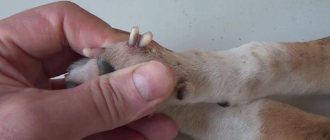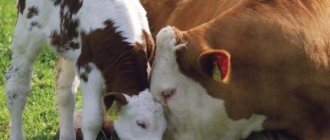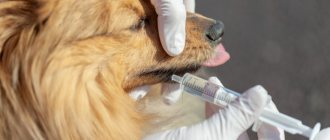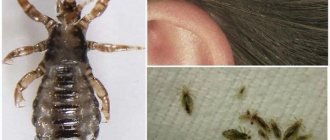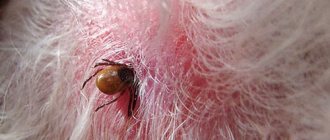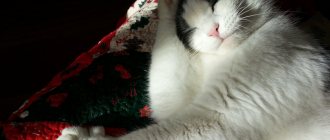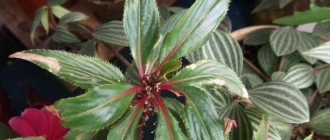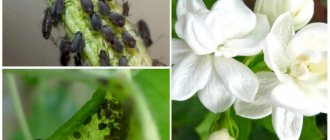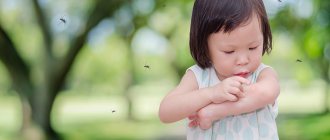Cattle animals, when in contact with their own kind in the herd, run the risk of contracting one or another parasitic disease.
Calf
Pediculosis is one of the most common problems of this type. The presence of lice in cows and calves can change the life of a cow and its owners in a negative way, causing them a lot of trouble.
The harm to the body of a cow (calf) can be quite significant. Lice bites are accompanied by severe allergies, the animal's body begins to itch, and the cow begins to behave very restlessly.
If you do not pay attention to eliminating the problem, you can bring the animal to a state of significant exhaustion.
Pediculosis is a provoking factor in infectious diseases in cattle (both viral and bacterial in nature).
Louse under a microscope
Lice are carriers of protozoa, etc.
Routes of infection and clinical symptoms
The reservoir of infection is infected cows. Lice have no vision, but they have a good sense of smell and touch, and they crawl onto other animals in close contact. Lice eggs, the so-called nits, are attached to the roots of the hairs with a specific sticky mass that is not washed off with water. But while lying down, some of the nits become detached and stick to the skin of another individual.
In cold weather, lice are located on open surfaces - along the back; in summer they move to the ears, groin, and around the horns. In calves up to 2 months old, lice are located on the lower neck and legs.
The following pathological symptoms are observed in lice-infested individuals:
- the animal shows aggression;
- hemorrhages appear on the skin and dermatitis develops;
- the skin itches, the animal rubs against protruding objects;
- chewing gum stops and lactation stops;
- calves develop anemia;
- In animals, immunity decreases and morbidity increases.
Signs of lice in cows
Lice in cattle most often occur due to improper maintenance. A dark room, unsanitary conditions, and a dirty cow’s body create favorable conditions for the proliferation of ectoparasites.
Signs of lice in cattle:
- Changes in behavior – agitation, aggressiveness, sudden jumping up for no apparent reason. Or apathy, lethargy, powerlessness.
- Trembling throughout the body, constant desire to scratch oneself against a tree, fence, or other suitable structure.
- Weight change - cows lose their appetite, stop eating, and lose weight.
- Deterioration in milk yield. A nervous animal experiences severe stress, which affects its physical and mental well-being. The amount of milk decreases.
- Bites, bumps, abrasions, and scratches are visible on the skin.
- Lice in calves prevent the young animals from developing. If the infection is severe, it exhausts the animal and leads to death.
Lice in cattle are localized on the head, neck, horn area, and near the tail. The parasites feed every 2 hours, the process takes about 40 minutes. During a bite, a special substance is released that thins the blood. It also causes a severe allergic reaction in the form of unbearable itching. The cow is physically and mentally exhausted, and risks contracting more serious diseases.
Lice are carriers of protozoal, bacterial, and viral infections. The insect does not infect directly through contact with blood. But if it is crushed, splashes of pathogenic microorganisms fall on the wounds of the animal, and infection occurs.
Lice on cows
Types of lice that parasitize cattle
Lice are small, wingless insects, highly specialized parasites that live only on one or some related species of animals. Infestation with these insects is called pediculosis.
Most often, cows are affected by the following subspecies of lice:
- The short-headed cow louse is a fairly large insect, the length of an adult individual reaches 4 mm. The abdomen of the parasite is dark with a blue tint, the head and chest are colored yellowish-gray. The nits are white, the eggs are covered with a thick, dense shell. The life cycle of a louse is 14-15 days, during which time the louse lays 10 to 18 eggs. After another 1-2 weeks, new individuals hatch from the eggs and the cycle soon repeats. Insects concentrate mainly on the necks of animals, where a large accumulation of white nits can be found.
- Long-headed calf louse. The size of this louse does not exceed 2 mm in length, however, its life expectancy is quite long - about 4 weeks. Parasites hatch from eggs in the 2nd week after the clutch has been laid. After another 2 weeks, the insects reach maturity and also begin to lay eggs. It is very difficult to detect a long-headed calf louse in the fur of a sick animal due to its small size.
- Hairy louse. This is the smallest parasite that infects cattle - its length is only 1-1.5 cm. The life expectancy of a hair louse reaches 3-4 weeks. Parasites are concentrated on the cow's head. A distinctive feature of this louse is its low mobility - it practically does not move around the animal’s body after it attaches itself to a certain area of the skin. The parasite lays one egg per day, sometimes two. The louse is detected by the characteristically curved hairs of the fur, to which the female parasite attaches its eggs.
The source of lice spread in most cases is already infected cows. Parasites spread to the fur of healthy individuals through touch in crowded conditions and during sexual contact during mating. Infection can also occur through dirty bedding or care items on which lice nits remain.
What do lice look like on cows?
Lice are wingless small insects that parasitize, among other animals, cows. Their size, depending on the type, ranges from 1 to 5 mm. The body of the louse is elongated, flattened towards the back and abdomen.
The head is narrowed at the front. The color of an adult ectoparasite is usually inconspicuous. They feed exclusively on blood, every 2 hours, the blood suction process lasts about 40 minutes. The life cycle of lice, like other insects, consists of several stages. After sucking blood, the louse lays eggs called nits. They, in turn, stick to the root section of the hair.
After one and a half to two weeks, larvae hatch from the nits - nymphs, which differ little from adult individuals, except perhaps in size, and immediately begin to parasitize. After 11–14 days, the nymphs become adult, sexually mature insects.
Ectoparasites do not form in the external environment, but under favorable conditions they can live for about 3–7 days. The localization of insects depends on the time of year.
During the cold season, lice look for warmer places on the cow’s body:
- at the base of the horns;
- in the upper parts of the mane, neck, back;
- in the groin area.
During the warm period, parasites spread throughout the animal’s body, and their places of “settlement” are the neck, ears, legs and shoulder blades.
The harm that lice cause to the cow’s body is as follows:
- When biting, the louse releases a special substance that thins the cow's blood and causes severe allergies in the form of unbearable itching. As a result, physical and mental exhaustion of the animal occurs and, as a result, there is a danger of more serious illnesses.
- The insect is a carrier of protozoa, bacterial and viral infections. A louse cannot infect directly through contact with blood. The risk of injury arises if the insect is crushed - then drops of liquid flying away with harmful microbes fall on the sores of the cow, and infection begins.
Short-headed cow louse
This is the largest louse - it has a length of up to 4 mm. The abdomen of this insect is dark blue, the chest and head are yellow-gray, the eggs are white and have a thick shell. The life cycle of the parasite lasts approximately 2 weeks, during which time the louse manages to lay 1 egg daily in the animal’s hair. After 1–2 weeks, a nymph emerges from the egg, and after another 2 weeks it grows into an adult, and everything goes in a new circle. Short-headed cow lice can be identified by the easily visible white nits on the neck.
Important! The appearance of lice in cows indicates a decline in the animal’s immunity.
Long-headed calf louse
This ectoparasite is only 2 mm long, dark in color, and lifespan is approximately 30 days. The insect is born 14 days after the adult female lays eggs. After 14–20 days, the nymph will grow into an adult louse. It is difficult to notice a long-headed calf louse on an animal’s body.
Hairy louse
The smallest parasite: the length of the male is 1.5 mm, and the length of the female is 1 mm. This type of lice is inert and can therefore only be transmitted by contact. The insects look like dark dots on the cow's body, and the eggs of this louse are white. The life cycle is 27–29 days. The hairy louse lives on the animal's head and, once it has attached itself, no longer moves. The female lays 1–2 eggs per day, which she herself attaches to the owner’s fur. The presence of a hairy louse on an animal is determined by the bent hairs on which the eggs of the parasite are suspended.
How pathogens act: symptoms
The fact that your cows, goats or sheep have lice is determined by the following symptoms:
- Constant skin itching. This symptom is the main one.
- Since pets scratch their skin to escape itching, injured areas can become inflamed due to an infection that has entered there. The blood protruding from the resulting wounds dries and turns into crusts. The elasticity of the skin is gradually lost, it begins to peel off and becomes rough.
- Animals begin to lose weight, and even deaths are common among very young animals.
Any livestock breeder, not necessarily a veterinarian, can diagnose siphunculatosis, because the symptoms are very specific and vivid. Mobile lice and new growths can be easily detected if you carefully examine the skin at the roots of the hair and the hair itself.
Please note that the laid microscopic eggs are firmly glued to the body by female insects with a special substance. It is resistant to many chemicals, so nits are not so easy to get rid of.
Pediculosis is very easy to become infected as a result of simple contact between a healthy individual and a sick person, as well as through various hygiene items and shared bedding. The pathogen is dangerous regardless of what stage of development it is at, whether it is a larva or an independent insect.
Lice is an all-season disease, however, the most troublesome periods are those times of year when humidity rises and it becomes cooler. On summer days, thanks to active molting, dryness and good nutrition, lice become noticeably smaller.
Skin diseases of cows
Raising cows is not that easy. It is not enough to know what they eat and how to get milk from them. Cattle need careful care, as they are susceptible to various skin and infectious diseases. Creation of living and nutrition conditions to the fullest. Have the number of a veterinarian who can serve them for vaccinations and preventive examinations. But still, if the disease has overtaken your animal, you do not need to postpone treatment until later, hoping for self-healing, but take the problem seriously.
Firstly, if a cow has obvious skin diseases, the first step is to isolate it from the rest of the herd. Otherwise, an outbreak of the disease among the entire livestock cannot be avoided.
Veterinarians often prescribe owners self-treatment with prescribed medications. Problems such as scabies, lichen, mites, lice are not uncommon among households and cause very severe itching in the affected individual, which interferes with normal nutrition and ultimately reduces productivity.
The disease trichophytosis, or as everyone is used to saying, lichen, is a common pathological reaction to skin damage by a fungus. In cows, this manifests itself as pain and discomfort at the site of the lesion. It spreads rapidly and can even be transmitted to humans.
The main cause of the disease is the infectious animals with which the cow had contact, and the hygiene of the animal also plays an important role. The fungus can also enter the body through microcracks and wounds on the skin. The presence of lichen in livestock can be detected with the naked eye.
In the affected area, the first thing that appears is peeling, then crusts appear, and the hair begins to fall off. On the skin, the clinical picture will begin to appear in a week, the causative agent of lichen is the trichophyton fungus, it acts in the cells of the epidermis and blocks the hair follicles.
In addition to external signs, lichen has a negative effect on the general condition of the cow. She loses weight, young animals lag behind in development, and there is a decline in milk production and reproduction.
The incubation period is up to 28 days. The main diagnostic criterion is the appearance of tubercles with the death of skin cells and hair loss. In small calves, the head area is primarily affected (circles around the eyes, mouth, forehead, ears). Adult cows have these manifestations throughout the body (neck, back, thoracic region).
Adults suffer from superficial and erased lesions, while calves suffer from follicular lesions. The vesicular shape is characteristic of the perineum and inner thighs.
Complicating treatment is the fact that fungal spores are quite resistant to environmental influences. They can exist on fallen skin crusts for years. When exposed to very high temperatures, they die only after three minutes. Acid-based disinfectants only take effect after twenty minutes.
The treatment should be handled by a veterinarian, he will determine the form and prescribe the best remedy. Today, several simple ways to combat the disease are used:
For the entire duration of treatment, you need to regularly disinfect the room where the sick animal lives.
Scientifically called Demadecosis, the causative agent in cattle is the demodex mite. This parasite actively multiplies on the sebaceous glands and hair follicles of the skin, creating colonies there, with more than a thousand mites in one. In recent years, the incidence of mange has increased greatly, and not only from cows, but also from other domestic animals. Since the transmission mechanism is contact, the sick animal must be isolated from the rest for the duration of treatment.
Manifestations of scabies are more typical in the neck and head, back and chest areas. In these places you can observe small tubercles up to a centimeter in diameter, with a wet surface. When pressed, a grayish-white liquid flows out, which is infested with parasites; it is used for microscopic examination. In cows, scabies may not be accompanied by itching, so this study has great diagnostic value.
The disease can be treated by the following means:
- 5% Decryzil emulsion with 1% Chlorophos solution, treat affected areas 5-7 times a day.
- Subcutaneous injections of Ivermectin 0.2 grams per kilogram of weight.
- Sevin suspension 1% for treating the animal until complete recovery.
Prevention consists of routine examinations of the animal by a veterinarian; he is able to identify signs in the early stages, which will allow timely isolation of the sick cow.
Wingless insects are permanent parasites. They have features in the form of an elongated and flattened body in the dorso-abdominal direction, and a narrowed head. They parasitize animals with thick fur, especially often in winter. Lice actively act on the host’s skin, feeding on his blood; after each sucking, they lay eggs (nits) in the root part of the hair.
Read also: Rabbit milk: composition, benefits, feeding baby rabbits
When they bite, they injure the skin and introduce toxic saliva into the wound, which has an irritating effect. The skin begins to itch very much, and frequent scratching leads to dermatitis; with massive lice infestation, the animal becomes restless. Places where there is a strong accumulation of lice become bald over time.
Young calves are most likely to suffer from lice.
The animal must be isolated, as lice can jump from one cow to another. Insecticides are actively used for treatment:
- 5% Chlorophos - spray livestock to remove lice, but since nits are more resistant to its action, you need to re-treat it after 5-6 days.
- In winter, Chlorophos is used at a 3% concentration.
- Folk remedies for removing lice are: a solution of salt with vinegar, and treatment with kerosene.
- Some people use ordinary ash, which they rub on the animal.
The great advantage of folk remedies is that the milk from the animal remains edible, which becomes impossible with drug treatment. When a cow is given medicines, the milk is also saturated with them, so it can be consumed when the cattle has fully recovered.
But it is still not recommended to self-medicate, since the effect may not be obtained, and the disease will progress to such an extent that it will be impossible to cure it, and the owner will lose part of the farm.
Treatment
Remedies for parasites
There is no need to specially isolate animals, since with siphunculatosis, most often all cows that have been in contact with the carrier are already infected. In this case, the easiest way is to treat the entire herd at once. Therefore, they carry out treatment at home, treating not only the cattle with medicinal preparations, but also the territory where the cattle are kept.
Pediculosis in cattle is treated with the same means that are used to remove fleas and ticks from any domestic animals:
- The most effective modern drug is injectable Ivermectin, which can also expel worms. If using Ivermectin is inconvenient for some reason, you can buy lice preparations for cattle at a regular pet store.
- Neostomazan, Butox, Dermatol work equally well against all ectoparasites, including ixodid ticks. Use medications according to instructions. Neostomazan and Butox must be diluted. You can treat the room with the same solutions to get rid of parasites that have fallen on the floor.
- Among the injectable medications for removing lice, you can use Baymek, Rolenol, Aversect, Avertin.
If the cow is alone in the house and there is time for long-term treatment, treatment with folk remedies can have a good effect: rubbing ash into the cow’s fur in the areas where parasites live. The first time, rub the ash for at least 2 days in a row to destroy imagoes and larvae. The second time a few days later, to remove new parasites that had hatched from the nits. Only in this case will the folk remedy give a healing effect. Otherwise, the parasites will breed again.
How to treat lice in calves
It is known that cows get lice due to violations of housing conditions. Calves are more susceptible to parasite bites because their immunity is not strong enough. The danger of wingless insects lies in their ability to carry a lot of serious diseases. Lice are carriers of viral, protozoal and bacterial diseases. If a sucking insect is found on the body of an animal, the infected cow must be immediately isolated and the stall treated with disinfectants.
Folk remedies
There are a huge number of folk remedies for the treatment of pediculosis. Sometimes they are inferior in terms of veterinary drugs, but they also have their advantages. Most often, they are products of natural origin and do not have such an aggressive effect on animal meat and milk.
How to remove lice from a calf using folk remedies:
- Wood ash. For two weeks, it should be rubbed into the animal’s fur, paying more attention to places where parasites accumulate. This should be done with moderate intensity so as not to cause an allergic skin reaction.
- Any vegetable oil. The consistency of the substance makes it difficult for fleas to move throughout the animal's body. The oil also creates a thin film that blocks oxygen for the lice. Because of this, they leave the victim to seek more favorable conditions.
- Wormwood decoction. To do this, pour boiling water over the flowers of the plant and leave for 30 minutes. Grated tar soap and hellebore water should be added to the decoction (these ingredients can be bought at the pharmacy). The resulting product is rubbed into the hair of calves and cows for 7 days. After a week's break, the course should be repeated.
- Vinegar. This method helps to eliminate not only adults, but also nits. Vinegar should be diluted with water in a ratio of 1:2. The resulting solution is applied to the fur in areas where fleas accumulate.
- Birch tar. This product is rubbed into the places where fleas most often find refuge: head, neck, tail.
- Kerosene. Livestock breeders often use this method, although it is not the most pleasant. After all, not only people, but also animals do not like the smell of kerosene.
During treatment, you should carefully monitor the animal's condition. After all, if it does not help, the owner risks developing the disease and losing the cow or calf. Young individuals are much more susceptible to the disease than adults. Therefore, the treatment of calves should be taken more seriously. Pediculosis is very easy to contract, so sick individuals are completely separated from healthy ones.
Getting rid of lice: treatment regimen
How is bovine siphunculatosis treated? To remove lice from a goat or other animal belonging to the category of cattle, you need to adhere to a certain scheme, which includes both medicinal and traditional methods. First, about medications. Despite the fact that siphunculatosis is a tenacious and painful disease for them, diligent adherence to the recommendations of veterinarians and the use of special medications will certainly yield positive results.
So, in order to destroy lice from a cow once and for all, the treatment should be as follows: all drugs used must be used repeatedly; After detailed initial treatment, you need to wait a week and only after that carry out additional treatment of the hair itself. This procedure must be repeated at least three times. This cyclicity and frequency is due to the fact that the incubation period of parasites is 21 days.
Here is a small list of those medicines that have proven effective in the fight against lice:
- Emulsion in concentrated form called neostomozan. The drug must be diluted immediately before use, because its shelf life is only 120 minutes. The main active ingredients in the drug are transmix and tetramethrin. The diluted product is applied to the animal’s hair using a spray bottle or an ordinary sponge and left for 2 hours, then washed off. After a week or 10 days, the treatment is repeated. Neostomozan can be sold in special canisters, ampoules or bottles. This drug kills lice, but does not have the same effect on nits.
- Butox is another type of emulsion with the active ingredient deltamethrin. The product is a long-acting drug, so after application it is washed off only after 2 weeks. The next treatment is carried out after 7 days.
- Another emulsion called sebacil. It is used both for rubbing and washing animals. The product is washed off after 5 minutes. The drug should not be used during feeding of livestock.
Remember that not only sick individuals, but also the entire herd, as well as the premises in which it lives, should be treated. By the way, all drugs are classified as poisonous, and it is necessary to prevent the product from being licked off. For this purpose, a special collar is worn. If a sick individual feeds her cubs or the babies themselves are sick, then they need to be treated with more gentle means, such as:
- Ectomin. It is used once for bathing, but the treatment can be repeated after two weeks for preventive reasons.
- Suminak. It is an emulsion. It perfectly rids pets not only of lice, but also of lice and ticks. They can also be used to treat rooms. The product can be left on the hair of individuals for 60 to 90 minutes, but then must be washed off using plenty of water.
- Brovermectin (ivermectin). Available in the form of a solution for injections. The drug is administered once, but just as in the case of ectomy, the injection can be repeated after 15 days.
During the treatment period, the milk is not suitable for human consumption and is discarded after milking. Usually this is done for no longer than 5 days.
There are, of course, much more solutions, powders, and various aerosols suitable for treating the animal’s body. You can choose the one that your veterinarian recommends or you yourself find the one that is most suitable.
Important
However, do not forget the main thing: the result is directly related not only to the quality of the drugs used, but also to the careful application of this drug to the skin and hair. And give preference to the least toxic products. During the summer, preventive and therapeutic treatment should be carried out twice with an interval of 10 days, and in winter - also 2 times, but the interval should already be 15 days.
Powders
The drugs do not require dilution with water. The powder is evenly distributed over the animal's fur.
| Name | Properties | Application |
| Deltamethrin powder | The active substance in the composition (deltamethrin) blocks the transmission of impulses, causing paralysis and death of the parasite. | ● Dosage – 1 g per 5 kg of live weight. ● The substance is sprayed evenly over the fur and rubbed a little into the skin. ● Animal slaughter is permitted no earlier than 20 days after the last treatment. |
| Ectosan powder | The composition includes a pyrethroid, which affects the nervous system of lice at any stage of development (larvae, adults). | ● Treatment is carried out individually: 100-200 g per large individual. ● The substance is applied in a thin layer. First spray on the back, then on the head, tail, dewlap. ● Apply with a brush. |
| Insectoacaricidal powder | Causes paralysis and death of lice. | The dosage is calculated based on the intensity of infection and the live weight of the animal: ● Cattle – 100-20 g per head; ● goats, sheep – 50-100 g. The drug is rubbed into the deep layers of the coat with a brush. |
Aerosols
The most effective sprays against lice are:
- “Ivermek” - the components of the drug help destroy lice, eliminate itching, pain, and accelerate wound healing;
- “Stomazan” - the emulsion should be diluted with water and applied with a spray bottle to the coat (from 500 milliliters to 1.5 liters per animal);
- “Butox” - apply the solution with a spray bottle, wash off after two weeks, re-treat after seven days;
- “Sebacil” – soak the cow’s hair generously with the product, rinse off with warm water after five to seven minutes;
- “Cyflunit Flock” is a spray with therapeutic and preventive properties. It is necessary to apply along the spine to protect against lice for up to a month.
Treatment with a combination of sprays and injectable drugs against parasites - Ivermectin, Baymek, Clozatrem - gives a good effect.
Destruction of lice with folk remedies
Owners of private household plots and peasant farms can destroy lice from cows and calves by using folk remedies used in the old days. Moreover, the use of these products does not have a harmful effect on the quality of milk produced.
- Rub wood ash into the skin for 2 weeks.
- Treatment of fur with kerosene.
- Dilute salt and vinegar in equal proportions, wipe hard-to-reach areas of the body until the parasites are completely destroyed;
- Application of birch tar. The tar is rubbed for 10 days in areas where animals are affected by lice (horns, neck, ridge, tail area).
- Washing the animal's fur for 20 days with a decoction of wormwood (keep the wormwood in 1 liter of hot water, add pharmaceutical hellebore water and tar soap).
Prevention. The main measures to prevent lice from appearing on a cow are: Maintaining constant cleanliness in the barn. Complete animal nutrition. Periodic washing and cleaning of the cow's skin. Using a 0.5% chlorophos solution to treat the room in which the cow is located, as well as the animal itself. It is recommended to treat the premises either before the stall period or in the summer.
Disinfection of premises and animal care items with insecticides. Occasional use of odorous substances that repel insects - Hexamide, Dicresil. Hexamide has a repellent effect, and Dicresil has an acaricidal and insecticidal effect.
Traditional methods of treating lice in cattle
Is it possible and how to remove lice from goats using folk remedies, as well as from cows and other animals? Such remedies do exist and can be recommended.
For example, the most common vegetable oil. They need to thoroughly lubricate the skin of the sick individual, thereby covering it with a protective film that envelops the parasites and deprives them of oxygen. In addition, because the oil is slippery, it is difficult for insects to stay on the hair, and they fall to the ground. For greater efficiency, it is recommended to add kerosene or diesel fuel to the oil.
To combat lice, you can use ash or tar. Cover the animal's skin with ash and leave it for a week without rinsing it off. This treatment should be carried out three times at intervals of 7 days. The tar should be left on the treated skin for 24 hours. It is safe to use even on calves.
Wormwood is another handy remedy. It needs to be boiled and treated with infected areas of the body. Due to its harmlessness, wormwood can also be used on newly born babies. It is also good to add this herb to food. Just remember that the milk will have a bitter taste after this.
Room treatment
Unfortunately, to finally solve the problem, it is not enough to remove parasites from a sick animal. When the cow returns to the stall, she can become infected again: lice nits remain in the bedding, feed, cattle care items, etc. To prevent this from happening, all utility rooms are disinfected using chemicals.
The most effective insecticides include:
- "Hexamide";
- "Dicresyl";
- "Chlorophos" (0.5%).
You can also use a special checker “PESHKA-V” to clean rooms from lice. The active substance contained in it causes paralysis in the parasites, and soon after this the lice die. The saber is harmless to animals and people; its constituent components disintegrate 3-4 hours after use.
Important! The method is dangerous because the chemicals contained in the bomb quickly react with water and can cause severe intoxication of animals. In this regard, drinkers and feeders are removed from the premises before treatment.
Seasonal treatments of the area where cows are kept are carried out, as a rule, in the summer months or before the stall period.
Prevention of parasites
There are a number of preventive measures that are very effective in solving the problem of preventing cow lice.
First of all, you need to monitor the cleanliness of the barn and provide balanced, nutritious nutrition for the cow.
Well maintained barn
It is important to wash and clean the cow's skin with planned regularity.
It would not be superfluous to regularly treat the animal and the barn premises with a half-percent chlorophos solution. There are a number of drugs that repel parasites.
It is also advisable to use them in the prevention of bovine lice. First of all, you need to take note of Hexamide, Dicresil, etc.
Preventive actions
The appearance of lice in calves and adult cows can be prevented by strictly observing the following preventive measures:
- in the room where cows are kept, it is necessary to maintain cleanliness and order - promptly change the bedding in which parasites can hide, remove manure, renew the water in drinking bowls, etc.;
- feed for cows must be fresh and varied; feeding musty hay or spoiled foods is unacceptable;
- it is advisable to periodically dilute the cattle diet with various vitamin supplements to maintain immunity;
- animal skins are cleaned and washed from time to time;
- The place where the herd is kept and the cows themselves are treated with a solution of chlorophos (0.5%).
Sources
- https://www.spas-agro.ru/zhivotnovodstvo/vshi-u-korov-simptomy-lechenie-medikamentoznymi-i-narodnymi-sredstvami.html
- https://AllVetDrugs.ru/bolezni/vshi/telyata/
- https://apest.ru/vshi-i-gnidy/unichtozhenie-vshej/vshi-u-korov/
- https://agro-puls.ru/rassada/kak-vyvesti-vshey-u-korovy-narodnymi-sredstvami-i-medicinskimi-preparatami.html
- https://moloko-chr.ru/articles/veterinary/esli-vshi-u-koz-korov-i-ovecz-algoritm-borby.html
- https://SeaHair.ru/vshi/vshi-krs.html
- https://dachamechty.ru/krs/zabolevaniya/vshi-simptomy.html
- https://fermilon.ru/hozyajstvo/zhivotnovodstvo/vshi-u-krs.html
[collapse]
